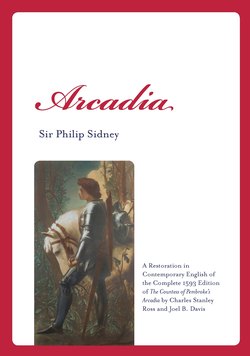Читать книгу Arcadia - Sir Philip Sidney - Страница 7
На сайте Литреса книга снята с продажи.
ОглавлениеPreface
Very little is known about Shakespeare between his marriage in 1582, when he was eighteen, and his emergence as an actor and playwright in 1592. But if he was anywhere near London, he knew about the courtier and war hero Philip Sidney, who died on October 17, 1586, three weeks after a bullet hit his thigh as he charged a supply line of Spanish troops bringing gunpowder to Zutphen in the Netherlands. His London funeral on February 16, 1587, just before that of Mary, Queen of Scots, was unmatched in lavishness for a non-royal until 1962, when Winston Churchill died.
Three years later, England’s war hero was recognized as an author when his name appeared on the title page of The Countess of Pembroke’s Arcadia. Shakespeare read every word, as can be seen in his earliest plays by the way he imitates Sidney’s obsession with tears and water drops, at times in a baroque or metaphysical manner—“Tears, drown yourselves” (Arcadia 3.34); “And every drop cries vengeance” (3HenryVI 1.4.148). In 1591, Sidney’s Astrophel and Stella appeared in a defective edition (the title character’s named should be spelled “Astrophil”) that obscured the story of a lover who suffers for stealing a kiss. Shakespeare again followed Sidney’s lead. He wrote a sequence of sonnets and, imitating his model, did not bother to provide a single narrative to connect the friend, the rival poet, and the dark lady. He also borrowed Sidney’s paradoxes—that Stella’s eyes are dark but bright, that the further away from her Astrophil finds himself, the more he loves her—for his own dark lady and lover.
In 1593, Sidney’s sister, the Countess of Pembroke, published a new edition of the Arcadia, now in five books instead of three, that completed the narrative left suspended in 1590. From either version Shakespeare could have borrowed the story of the blind Paphlagonian king in Book 2, which became the basis for the Gloucester subplot in King Lear. But a hitherto unnoticed connection between A Midsummer’s Night’s Dream, where four lovers chase each other through the forest outside Athens, and a game of tag in the Barley-Break poem (Lamon’s Song) that Sidney’s sister added to the First Eclogues, shows that Shakespeare kept up to date with the new edition of Sidney’s work.
In 1595 there appeared a pirated edition of an essay titled An Apology for Poetry, reprinted in 1598 under the title The Defense of Poesie when Mary Sidney put her brother’s complete works into a single volume. In this classic essay Sidney argues that poetry, by which he means prose fiction and drama as well as lyric poetry, is better able to teach moral virtue than either history or philosophy. History is too tied to actual events, and philosophy is too dry and difficult to understand. But poetry creates its own world. Having died before the great achievements of the English Renaissance stage, Sidney has little good to say about drama, but he urges English writers to produce literature that will surpass the best of France and Italy.
People often wonder what made Shakespeare great. How could he write popular plays that are still studied today? Why did he write in verse; indeed, why did he write complex drama and not just settle for bawdy jigs? The question of genius aside, Sidney’s challenge provides no small part of the answer. Echoes of the Arcadia abound in Shakespeare’s work, from Romeo and Juliet and Othello to the pastoral play The Winter’s Tale. Sidney was also a master of the art of oratory; his character’s speeches and letters offer lessons in subtle persuasion and ethical appeal that Shakespeare deploys so effectively. So great was Shakespeare’s debt, not just to Sidney’s work but to the whole conception that a great nation must have great writers, that it is hard not to hear a tribute to Sidney in the opening line of Shakespeare’s most patriotic play, Henry V, when the Chorus asks “for a muse of fire!” The name of one of Sidney’s heroes is Musidorus, which means “gift of the muses,” and the other is Pyrocles, whose name derives from the Greek word for fire.
Shakespeare’s jingoistic but at the same time unblinkered play courts comparison to Sidney’s fable about two young men so carried away by their romantic idealization of two royal sisters, Pamela and Philoclea, that they literally and unlawfully try to carry them away. At trial after they are caught, they display the dazzling ability to make speeches that characterizes the whole Arcadia. Sidney’s women also think logically and can express strong emotion in equally well-chosen words. Philoclea is only sixteen in the story and uncertain in love, but her strength of mind is apparent when she argues against Pyrocles’ wish to kill himself. Dignified Pamela composes a prayer that England’s King Charles I is said to have recited before he put his head on the chopping block in 1649. Queen Gynecia puts her own tormented passion for a man not her husband into eloquent speeches of self-reproach. The Arcadia contains plenty of comedy too, but it is thoughtful comedy, not slapstick, created by characters who sound ridiculous because their thoughts are ridiculous.
Our restoration of The Countess of Pembroke’s Arcadia is presented in a newly edited, readable edition based on the complete 1593 text. Spelling, punctuation, and occasionally words and grammar have been modernized for clarity. Titles and summaries have been added to the chapter divisions found in the 1590 edition but dropped in 1593 and subsequent editions.
Charles Stanley Ross
Purdue University
Joel B. Davis
Stetson University
